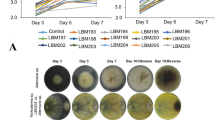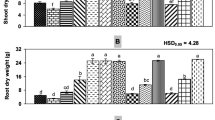Abstract
The effect of lettuce (Latuca sativa L.) germination and growth in nonsterilized potting compost of 0.1% and 1.0% w/w incorporation of fermenter biomass inocula of six strains of Trichoderma was investigated. Except for strains WT and T35 at 0.1 % w/w, all inocula inhibited germination. Biomass of strains WT, T35, 20, and 47 at 1.0% promoted shoot fresh weight, whereas strains TH1 and 8MF2 were inhibitory. In contrast, when biomass of strains WT, TH1, and 8MF2 was autoclaved and incorporated at 1%, shoot fresh weight was promoted, but the biomass of T35 was inhibitory. None of the strains incorporated at 0.1 % w/w increased shoot fresh weight, and autoclaved biomass of TH1, T35, and 20 incorporated at 0.1% w/w resulted in lower shoot fresh weights in comparison with uninoculated controls. The shoot dry weight of lettuce seedlings could be enhanced by germinating seeds in uninoculated compost and after five days' growth transferring them into WT-inoculated compost. Inoculum of strain TH1 when applied using this method was very inhibitory. With WT the degree of increase in shoot fresh weight and germination rate declined as the fermentation time to produce inocula was increased.
Similar content being viewed by others
References
Baker R (1988) Trichoderma spp. as plant-growth stimulants. CRC Crit Revs Biotech 7:97–106
Baker R, Elad Y, Chet I (1984) The controlled experiment in the scientific method with special emphasis in biological control. Phytopathology 74(9):1019–1021
Chang C, Chang Y, Baker R, Kleifield O, Chet I (1986) Increased growth of plants in the presence of the biological control agent Trichoderma harzianum. Plant Dis 70:145–148
Cox DR, Snell EJ (1989) Analysis of binary data, 2nd ed. Chapman & Hall, London, p 31
Ghisalberti EL, Narbey MJ, Dewan MM, Sivasithamparam K (1990) Variability among Trichoderma harzianum in their ability to reduce take-all and to produce pyrones. Plant Soil 121:287–291
Jackson AM, Whipps JM, Lynch JM (1991) In vitro screening for the identification of potential biocontrol agents of Allium white rot. Mycol Res 95(4):430–431
Jones RW, Lanini WT, Hancock JG (1988) Plant growth response to the phytotoxin viridiol produced by the fungus Gliocladium virens. Weed Sci 36:683–687
Lumsden RD, Carter JP, Whipps JM, Lynch JM (1990) Comparison of biomass and viable propagule measurements in the antagonism of Trichoderma harzianum against Pythium ultimum. Soil Biol Biochem 20(2):187–194
Lynch JM (1987) In vitro identification of Trichoderma harzianum as potential antagonist of plant pathogens. Curr Microbiol 16:49–53
Lynch JM (1990) Fungi as antagonists. In: Baker RR, Dun PE (eds) New directions in biological control: alternatives for suppressing agricultural pests and diseases. A R Liss, New York, pp 243–253
Lynch JM, Wilson KL, Ousley MA, Whipps JM (1991) Response of lettuce to Trichoderma treatment. Lett Appl Microbiol 12:59–61
Maplestone PA, Whipps JM, Lynch JM (1991) Effect of peat-bran inoculum of Trichoderma species on biological control of Rhizoctonia solani in lettuce. Plant Soil 136:127–263
Moffatt JS, Bu'Lock JD, Tse Hing Yuen H (1969) Viridiol, a steroid-like product from Trichoderma viride. Chem. Commun. Vol 17 839
Ousley MA, Lynch JM, Whipps JM (1993) The potential of Trichoderma as a consistent plant growth stimulator. Biol Fert Soils, in press
Papavizas GC (1985) Trichoderma and Gliocladium: biology, ecology, and potential for biocontrol. Annu Rev Phytopathol 23:23–54
Paulitz T, Windham M, Baker R (1986) Effect of peat: vermiculite mixes containing Trichoderma harzianum on increased growth response of radish. J Am See Hort Sci 111(5):810–816
Ridout CJ, Coley-Smith JR, Lynch JM (1986) Enzyme activity and electrophoretic profile of extracellular protein induced in Trichoderma spp. by cell walls of Rhizoctonia solani. J Gen Microbiol 132:2345–2352
Windham MT, Elad Y, Baker R (1986) A mechanism for increased plant growth induced by Trichoderma spp. Phytopathology 76:518–521
Author information
Authors and Affiliations
Additional information
Offprint requests to: J.M. Lynch.
Rights and permissions
About this article
Cite this article
Ousley, M.A., Lynch, J.M. & Whipps, J.M. Effect of Trichoderma on plant growth: A balance between inhibition and growth promotion. Microb Ecol 26, 277–285 (1993). https://doi.org/10.1007/BF00176959
Received:
Revised:
Issue Date:
DOI: https://doi.org/10.1007/BF00176959




